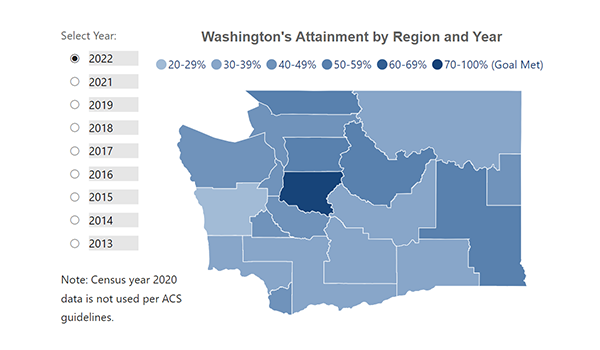WSAC Research Digest #5: Attainment

This is the fifth of the series of WSAC Research Digests that highlight interesting data insights and takeaways from WSAC’s new Strategic Action Plan (SAP) Dashboard. The goal of the series is to communicate and interpret data in a brief and informal manner to surface important education issues in the state.
Like many other states, Washington has a postsecondary educational attainment goal for its adult population that is aligned with projected labor market demand—70 percent of adults ages 25 to 44 should earn a postsecondary credential. This includes associate or bachelor’s degrees as well as other types of short-term credential, like certificates or industry-recognized certifications.
The attainment goal primarily serves to help the state increase the supply of Washington residents with the skills to meet future job needs. This is especially important since Washington ranks fifth among states for the share of jobs that will require postsecondary education by the 2030s. Plus, we know that jobs requiring more education or training also tend to pay more and are more secure in the face of economic downturns. So not only is educational attainment an important indicator of the state’s economic prosperity, it’s also a critical equity issue that offers benefits for individuals and their families. Check out the new attainment page of the SAP Dashboard to view the data.
Washington’s current postsecondary educational attainment rate is 61 percent, nine percentage points shy of our goal. This estimate includes 53 percent of adults ages 25 to 44 who have an associate degree or higher, and an additional 8 percent with a short-term credential.
But the statewide average simplifies the attainment picture and there are major disparities when we look at attainment for different regions and populations within the state. WSAC understands that to pursue equitable outcomes, we must not only improve our overall educational attainment but seek equity for each region and racial/ethnic group. (Note: disaggregated attainment data only refers to associate degree or higher and does not include short-term credential estimates due to data availability.)

Take a look at the state map. It’s probably no surprise that the region with the highest attainment rate is King County. In 2022, 70% of King County residents ages 25 to 44 had at least an associate degree. And if we had the data to add short-term credentials, the attainment rate would likely be even higher, surpassing the state goal. But King County is the only region in the state that has met the statewide attainment goal, at least as far as we can tell with the data we have. The region with the next highest attainment level is Whatcom County, where 57 percent of adults hold an associate degree or higher, substantially lower than the attainment rate in King County. The third highest attainment levels are found in Snohomish, Chelan, and Douglas Counties, with a 53 percent postsecondary degree attainment rate.
On the other end of the spectrum is the Grays Harbor and Mason County region which has the lowest educational attainment in the state—just 28 percent of adults hold an associate degree or higher. The next lowest attainment rates are in Yakima, Grant, and Kittitas Counties with a 30 percent postsecondary attainment rate. Relative to King County, though, these regions are much less populated. Since King County is by far the most populous region in the state, the high attainment rate inflates the statewide average and obscures the lower educational attainment in more rural areas of the state.
Of course, labor market needs vary across the state’s various geographies. There may be more jobs in King County that require a higher level of education—such as those in tech and research—than the more agrarian industries that dominate much of Central and Eastern Washington. But there is also increasing need for credentialed workers in less populated areas of the state as well, such as in health occupations and other specialized fields. Demand for workers with STEM education and training is rising in all regions, including more rural areas of the state. Plus, jobs requiring more education and training tend to pay more, so they can also offer opportunities for economic mobility.
Substantial disparities are also evident when we examine attainment rates by race/ethnicity, pointing to another significant equity issue. While nearly four out of five Asian adults hold an associate degree or higher, just one out of five American Indian or Alaska Native adults have one. More than half of white adults in Washington hold a postsecondary degree, but less than one-third of Hispanic or Latino adults do. These gaps signify that the state has a long way to go to ensure equal opportunities for postsecondary education for all, and the stakes are high—addressing these gaps in attainment could also help address the persistent racial wealth gap.
While the labor market landscape may vary, there is a growing demand for workers with postsecondary credentials throughout Washington. Ensuring access to postsecondary education and training opportunities for Washington residents across the state and promoting equity across racial/ethnic communities can help us move closer towards our attainment goal while also creating a more just future for all Washingtonians.
Start exploring: https://wsac.wa.gov/attainment-dashboard
 Skip to main content
Skip to main content


